Wasting food is throwing out food. Apparently, in Australia, it is estimated 330 kg per person is thrown out every year. (here) This creates two problems: firstly the wasted resources in producing the food ( water, labour picking, packing, transporting the produce, marketing and advertising, selling, money used buying it ) and secondly, landfill and the resulting methane.


About a third of all food produced in the world gets thrown out. This results in 8% of global greenhouse gases and costs our economy $20 million a year. We throw out 7.3 million tonnes of food a year or one in five bags of groceries. So every fifth dollar spent on food goes into the bin.


www.environment.gov.au
How do we avoid over buying food? Generally food planning or menu planning is recommended. The internet is awash with lovely looking meal planning pages and clever tips on using everything. I’ve tried to use them.They tend to be very attractive. It just doesn’t work for me. I am the planner in this household. I know what is to be used and when it needs to be used. We rarely throw out food and usually shop once a week.
My own system works because we have a stock of salmon, white fish, chicken and beef in the freezer and rotate as the mood takes us. We talk about what we’re cooking for dinner then put that to thaw in the fridge, if needed. This is supported by a weekly purchase of fruit and vegetables plus frozen vegetables, too. We go to a green grocer who only sells seasonal produce so it is well priced and fresh. We regularly eat the same sort of things for breakfast, such as fruit, yoghurt and toast, and the same sort of things for lunch, too, as well as leftovers.
We share the cooking. My husband prefers cooking steak or fish and adding vegetables. I usually get inspired after I’ve checked what needs to be used or what is available. We have a well stocked pantry and buy fresh bread every two days. I make my own rye sourdough.
I really dislike wasted food. I can turn leftovers into frittatas, souffles, pies, pasta sauces, fritters and soups. We always have eggs and stock, both frozen homemade and bought. Having fresh herbs growing in the garden adds flavour and interest. Neighbours happily share fruit from their lemon and kumquat trees and we have a lime tree.
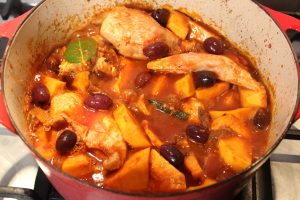

Today I wanted to use some chicken from the freezer. I have had a post-Christmas clean out of the fridge. I like to make recipes which result in two or three meals for two people. The recipe I’ve made is loosely based on Jamie Oliver’s CHICKEN CACCIATORE. I used
- 2 small brown onions
- 1 tbspn crushed garlic
- 250gm smoky bacon
- large sprig rosemary
- 650gm butternut pumpkin/squash
- 1 jar tomato pasta sauce
- 4 large chicken breasts
- 8 large olives
Normally I would add mushrooms but I didn’t have any. I also added 4 anchovy fillets because I usually do, but this recipe did not include them.)
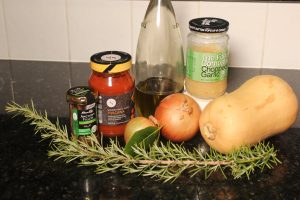

METHOD
Preheat oven to 170°C/375°F. Peel the onions and cut into eight segments. Put into a hot, oven proof pan with a splash of olive oil. Add the garlic and the chopped bacon (pancetta is better, but I wanted to use up the bacon) and the chopped rosemary plus the bay leaves. Cook for about 10 minutes. Stir regularly.
Meanwhile, peel and chop the pumpkin/squash into bite sized pieces. Add the chicken to the pan and brown , turning it regularly. Add the pumpkin and the sauce. Fill the tomato pasta sauce jar ¾ with water, shake with the lid on, add to the mixture. Add more liquid (water, wine,tomato juice) if necessary. Toss in the olives.
Bring to a simmer, put the lid on and put it in the oven for an hour. Season. Remove bay leaves. Serve with vegetables, rice or bread. SERVES 6.
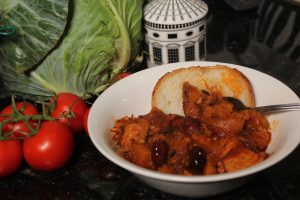

I’ll freeze a third of it and we’ll eat the rest for two dinners, once with bread and once with vegetables.
Some food scraps can be regrown, such as celery and bok choy, or fed to worms or the compost pile. I do not make compost, I make evil smelling muck, so sympathize if this is a problem for you, too. I do not dig scraps into the garden beds either, as this would encourage the river rats who need no encouragement.
Effectively storing all food requires preparation and organization. There’s plenty of information online about what should go in the fridge and what should go in the pantry. If it seems you wont be using what you’ve bought, freeze it or cook it and freeze it. Having a stock of frozen ready to thaw, heat and eat food is very handy for busy days. Or days when you just want to sit and read.
Avoiding single use plastics can also require some planning. Glass dishes with rubber or plastic multiple use lids are good. Some people rave about bees wax wraps. They can be added to the compost when they reach the end of their lives. I just don’t like them! The ones I tried come off in the fridge regardless of how carefully I wrapped and folded and tucked the edges under the container. I use silicone multi-use covers. I’ve been using the same ones for over two years, but they cannot be recycled. I also use hotel shower caps for bigger bowls! Just rinse and hang over a tap to dry, reuse. I like being able to easily see what is in the container.
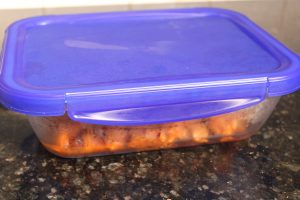

We use this size glass dish often for cooking. Leave the leftovers to cool then add the lid and put the dish in the fridge, easy.
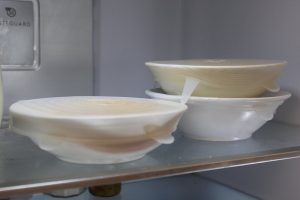

Silicone, stretch and seal wrappers, work really well for us. These are about two years old.
Storing leftovers so they are immediately visible when you look in the fridge is a good reminder. I know someone who has a special shelf where only leftovers can be placed. Someone else puts things needing to be used on the shelf at her eye height, right in the middle.
Fittingly, January 13th is Organise Your Home Day. How you do that is your own business! January 15 th is Strawberry Icecream Day, so that might be easier to celebrate.

Very helpful! Is there anything further I should think about next? Or is this enough?